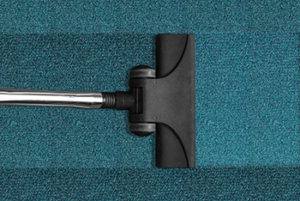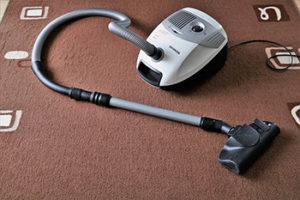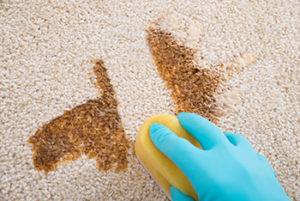Keeping your carpets clean and dry is important because if you don’t, your flooring can get damaged more quickly. What’s more, damp carpets can cause health issues. Are you trying to figure out how to dry wet carpet in the quickest way possible? Then I have some easy tips for you.
If you have an important event at your house and you’ve just cleaned your carpets, you’ll want to know the quickest way of drying them before guests arrive. So today I’ll be discussing reasons on why it’s important to keep your carpets dry, and I’ll give you a list of tips to dry them quicker.
Additionally, I’ve provided a FAQ section at the bottom of this article to help you with extra information about how to dry out wet carpet. Keep reading to find out more.
- Causes Of A Wet Carpet
- Why Is It Important To Keep Carpets Dry?
- Types Of Carpets That Dry Faster
- Tips On How To Dry Carpet Fast
- FAQs About How To Dry Wet Carpet
- Conclusion
Causes Of A Wet Carpet
Washing It With A Machine
To clean your carpets thoroughly, you need to use an industrial cleaner to remove stains and dirt from the fibers. These machines push water and detergent into the material of the rug. Then you will use a nozzle to suck up the soapy water and dirt from the carpet.
But most of the time, the machine won’t suck up all the water to the point where your carpet is completely dry. As a result, the surface of your rugs may still be damp after washing them with a machine. If you walk on your carpets while they’re damp, you may make them dirty again. Therefore, it’s important to dry your floor covers before you walk on them or move furniture over them.
Water Damage
A burst water pipe or a leaking roof can cause water damage in your home. Soaking wet carpets are not ideal; moisture can lift up or destroy the integrity of your rugs. Water damage can also cause mold growth and leave stains on your carpets if you don’t dry them thoroughly.
High Levels Of Humidity
In some cases, high humidity can make your carpet feel damp constantly. This will be an uncomfortable feeling when you walk on your floors. Additionally, damp areas on your carpet can cause mold growth and leave your house smelling musty.
If you walk over damp carpets with shoes, you can cause a stain that will be difficult to clean. But drying a wet carpet in areas with high humidity doesn’t have to be difficult. Read on, because I will be giving you tips on how you can reduce moisture in your carpets effectively.
Why Is It Important To Keep Carpets Dry?
Wet carpets can trap dirt particles in the fibers and be much more difficult to clean. Floor rugs will also be prone to mildew or mold growth if you don’t keep them dry. Carpets have a short service life between 10 and 15 years, and not maintaining them will reduce their longevity.
Furthermore, wet carpets can trap harmful bacteria in the fibers, which could be detrimental to your health. It’s important to dry out wet carpets because doing so eliminates foul odors in the home. Drying your floors maintains the look and luxurious feel of your carpets. Keeping your floors dry prevents staining and keeps your house looking neat, clean, and elegant.
Types Of Carpets That Dry Faster
Any carpet made from synthetic fibers will dry faster than natural, woven floor coverings. Synthetic materials absorb less moisture and therefore dry quicker than wool. A carpet made from olefin or polyester won’t fade easily or get damaged by harsh chemicals.
Although nylon carpets are also synthetic and a popular choice, they can get damaged easily by bleach or other types of chemicals. However, nylon is the preferred choice because it has a high retention. It will keep its shape and bounce back after being flattened by heavy furniture.
So if you’re looking for a carpet that’s robust, dries quickly, and won’t fade easily, then the best choice is nylon flooring. Nylon floor rugs come in an array of colors to pick from, and they’re easy to clean.
Tips On How To Dry Carpet Fast
Now that you know the importance of keeping your carpets dry, I’ve put together a few tips on how to make the process easier for you. Use the following tricks after you’ve washed your carpets or if you’ve experienced water damage.
Fans
If you have ceiling fans, you’re in luck. Even if you don’t, you can use any kind of fan to get your floors to dry faster. What you want to do is increase the circulation of air in your home. So if you have more than one fan, that would speed up the drying process even more.
Place fans all over the room and angle them toward the floor. This is so the wind from the fan can blow directly onto your carpets. Fans help when you can’t open your windows to allow air to flow through the space due to humidity.
There are specific fans specifically designed to dry carpets that have severe water damage. These machines blow large amounts of air onto soaking rugs to dry them out quickly. A carpet-drying fan is typically used when there’s water damage or flooding.
Some air blowers are portable so you can use them to dry patches of wet carpet. They’re versatile, too, because you can use them to dry laundry or upholstery.
Dehumidifier
Do you live in an area with high levels of humidity? It can be difficult to keep your carpets dry when you are in a region where it rains a lot and there are high levels of moisture in the air. The best way to solve the problem is to use a dehumidifier.
A dehumidifier is an appliance that reduces the humidity levels inside a home or office setting. The appliance can make your environment more comfortable and prevent the build up of mildew.
If you find that your carpets are damp after it rains and there’s a musty odor, you can remove the moisture by switching on a dehumidifier. You can also use a dehumidifier after you’ve washed your carpet. This machine can dry a 25-square-meter carpet in 12 hours.
Heaters
Warm air dries areas faster than cold air can. Heat can draw moisture out of the air and from your carpets quickly. So if you have portable heaters in your home, you may set them up all over your carpeted space to remove moisture from them.
You can get heater fans, which would probably work best. The heat combined with airflow will dry your carpets even faster. But be careful not to place the heater directly on your carpet because this can be a fire hazard. Place the appliance on a table so that you don’t run the risk of burning your carpets. An HVAC system could work faster than your heater, and if you have central heating, you can set the temperature. The heat from the HVAC system is safer and more convenient than that from a portable heater.
Opening Windows
If you’re not in a hurry to get your carpets dry, then all you have to do is open your curtains and windows. It’s best to wash your carpets when it’s a sunny day out so that the UV rays and the air from your windows can dry your carpets quicker.
I wash my carpets in the summer months when it’s a hot day outside so I don’t have to contend with moisture and a slow drying process. However, opening your windows is the slowest way to dry your carpets. If you happen to be going away for a weekend, I would recommend washing your floors before you leave. Then simply leave your windows open to dry your carpets naturally.
Use A Wet/Dry Vacuum
A wet and dry vacuum cleaner is a machine that can clean up dry dirt and liquid spills from any type of flooring such as:
- Laminate floors
- Carpets
- Hardwood floors
- Tiles
- Marble floors
- Vinyl tiles
If you’ve spilled a drink onto your carpet or your house was flooded by a burst pipe, you can use a dry and wet vacuum cleaner to suck up all the liquid. It’s the perfect appliance to use if you don’t own an industrial carpet cleaner.
This vacuum works similar to a standard machine, but it has more powerful suction so it removes dirt and moisture trapped deep within the fibers of your carpet. It may not completely dry your carpets, but it will remove most of the moisture so that they can dry quicker with the use of a fan, open window, or dehumidifier.
FAQs About How To Dry Wet Carpet
- How Do I Dry A Wet Carpet Quickly?
- How Long Does Wet Carpet Take To Dry?
- How Long Does It Take For Mold To Grow In Wet Carpet?
- Can A Wet Carpet Be Saved?
- Should I Use Baking Soda To Get The Smell Out Of Wet Carpet?
How Do I Dry A Wet Carpet Quickly?
The fastest and best way to dry carpets is to use heat and airflow. There are three types of systems you can use that use both heat and air: a dehumidifier, a heater fan, or an HVAC system. Heat evaporates moisture, and combined with airflow, it will work even faster to dry carpets.
Take care when using heating fans to dry your carpets. Put the appliance on a table and not directly onto your carpet because it could potentially burn your flooring. The safest system to use when drying your flooring would be a dehumidifier or an HVAC system.
The air will be dry for a while inside your home after using a heating system to dry your carpets. However, the heat and airflow will get the job done quickly, so you can move your furniture back into your home and walk on your floors without a problem.
How Long Does Wet Carpet Take To Dry?
It can take up to 24 hours for your carpets to dry, depending on what you’re using for the task. If you’re using fans or airflow from windows, the process can take several days to completely dry. But if the floors are simply damp and you use a heating system, it may take less time for your carpets to dry.
Typically it will take between six and 10 hours for your carpets to dry completely if they were simply damp from being washed. But this will also depend on the climate and time of year you pick to clean your rugs. The fibers will dry more quickly if you wash them during the summer months on a hot, dry day, as opposed to a rainy, cool day.
Your rugs will also dry a lot quicker depending on the materials they’re made from. If you pick synthetic fiber flooring, it will dry quicker because it doesn’t retain much moisture.
How Long Does It Take For Mold To Grow In Wet Carpet?
Mold can start to grow in a wet carpet within 24 to 48 hours. Typically the spores will begin to colonize between two and 12 days after the fibers are exposed to moisture. During this time, the spores won’t be visible. After about 21 days, you’ll be able to see dark green spots or patches on your carpets where the mold has started to grow.
To rid your carpets of mold, start by drying the carpet completely. Then wear a facemask, goggles, and gloves before you start removing the mold. Isolate the area so the spores don’t spread throughout your home.
Use a stiff-bristled brush to scrub away as much of the mold as possible. Then vacuum up the mold you’ve scrubbed off and follow that with a carpet-friendly detergent on the affected area. Don’t use bleach, especially if you have nylon carpets because it will damage the fibers.
There are carpet cleaners on the market that will work to remove mold. Once you’ve washed the area, use a wet and dry vacuum to suck up most of the moisture. Then you can use a carpet fan to dry the area thoroughly to prevent mold from growing back on the spot you have cleaned.
Some hardware stores sell antifungal coatings for carpets. These products come in a spray can, so you can easily distribute the coating over your carpets to slow down the formation of mold.
Can A Wet Carpet Be Saved?
Yes, you can save a wet carpet if it was drenched by clean pipe water or rain. But you’ll have to take the necessary steps to get it right. You want to prevent mildew buildup and stains from forming on your carpet. The best way to do that is to remove as much water from the fibers as you can, using an industrial carpet cleaner or a wet vacuum.
Then you should wash your carpets with a detergent in case there’s any bacteria or dirt left behind from the water. If your carpets were damaged by dirty water, it may be difficult to get them cleaned, but it can be done. You may opt for a professional carpet cleaning service to help you.
After you’ve washed your carpets, you must dry them immediately to prevent mold growth and staining.
Should I Use Baking Soda To Get The Smell Out Of Wet Carpet?
Yes, you can use baking soda to rid your wet carpets of unpleasant smells. Baking soda is an excellent natural cleaning aid that’s also a deodorizer. What’s more, the powder absorbs moisture so your floors will dry fast if you sprinkle baking soda over your wet carpets.
All you have to do is sprinkle some baking soda over the affected area and leave it on for 48 hours. The powder will remove any unpleasant smells.
Conclusion
Wet carpets are not ideal, especially if you want to preserve the longevity of your flooring. If you leave a carpet wet for too long, it can get stained or start to smell musty. That’s why it’s important that you maintain your carpets correctly, so that you don’t have to contend with mold growth or loss of fiber texture.
I hope that today’s guide on how to dry wet carpet provided you with some useful tips. These tips on how to get water out of carpets will work fast, so you can move furniture back into your space and even invite guests over again as soon as possible. Keep your carpets dry at all times so that it’s comfortable to sit and walk on.
Have you had problems drying your carpets in the past? What did you do to dry your flooring after a flood or other water damage? Let us know what your methods are for drying your carpets by leaving a comment below. Your tips and tricks might help other readers.
Back to Top



